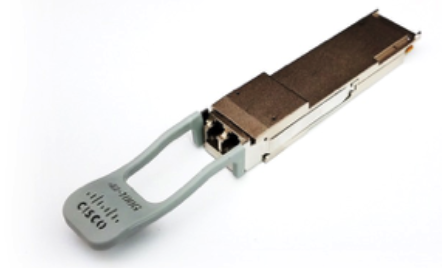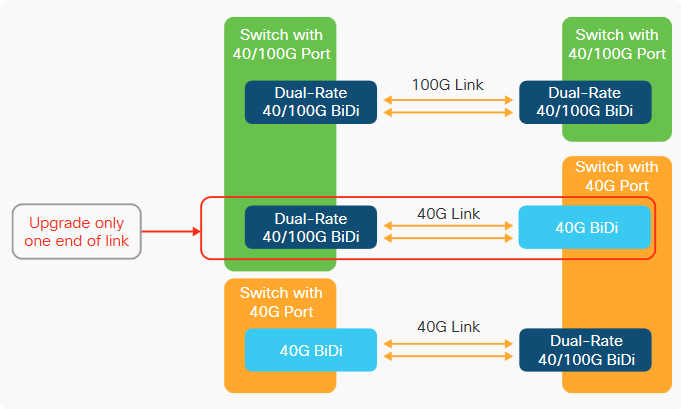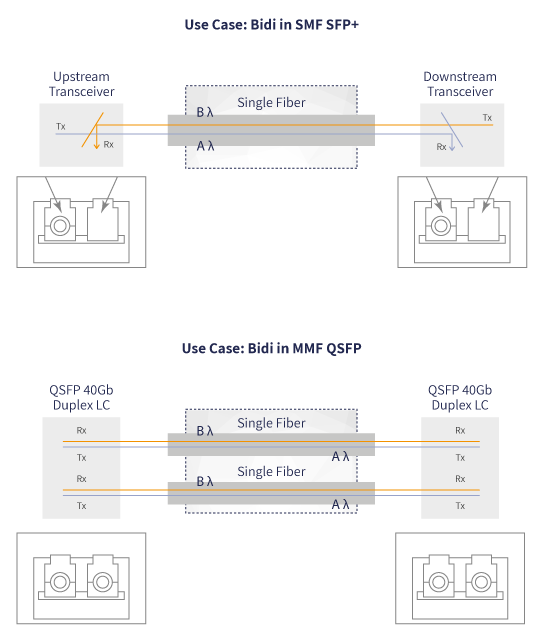The trending QSFP+ 40G BiDi pluggable optical transceiver has been introduced by Cisco since 2015. It broke the mold by providing 40Gb connectivity over the same fiber format (dual MMF) as 10G SR. Until then, 40G SR4 was the primary option, and required four times more fiber and more expensive optical connectors.
Data center traffic continues to grow, driven by increases in server activity, application density on virtualized servers, and demand for low-latency east-west connections between servers.
When the popular QSFP+ 40Gb bi-directional (BiDi) transceiver was released, it enabled data center operators, for the first time, to upgrade from 10Gb to 40Gb without the need to replace fiber cable infrastructure. The next generation dual-rate BiDi, which has both 40Gb and 100Gb operational modes, offers the same benefits and more.
The Cisco QSFP 40/100 Gb dual-rate BiDi transceiver can function as a 40Gb BiDi, matching its reach of 100m and 150m over OM3 and OM4 multi-mode fiber, respectively. In 100Gb mode, the dual-rate BiDi’s reach is 70m and 100m on OM3 and OM4, respectively. In both modes, the BiDi reach matches its SR4 counterpart.
As a single transceiver with these two modes of operation, the Cisco dual-rate BiDi enables data center operators to re-use their existing duplex LC-connectorized MMF infrastructure for migration from 10 Gb to either 40 Gb or 100 Gb Ethernet connectivity, or migration from 40Gb to 100Gb.
Figure2 shows the 100G BiDi Transceivers deployed in a leaf-spine logical architecture.
Features
- 40Gb and 100Gb dual-rate capability
- Backward compatibility with 40Gb QSFP+ BiDi
- QSFP28 form factor
- Operates over duplex LC-connectorized MMF fiber infrastructure, same as 10Gb SR and 40Gb BiDi
- Onboard forward error correction
- PAM4 optical modulation
- Bi-directional optical technology
- Enables incremental upgrade to 100Gb from 10Gb SR or 40Gb BiDi
Backward compatible with Cisco’s 40Gb BiDi technology
Only Cisco offers backward compatibility with native 40Gb BiDi transceivers in a QSFP28 form factor. Like the native 40Gb BiDi, the dual-rate 40/100 Gb BiDi transmits bi-directionally on both fibers, using nominal wavelengths of 850nm and 910nm and passive wavelength division multiplexing (WDM) filters at either end to isolate Tx and Rx channels. In 40Gb mode, it transmits and receives 20Gb NRZ channels on each fiber, for a total aggregate bandwidth of 40Gb.
In 100Gb mode, it operates 50Gb PAM4 channels, for a total aggregate bandwidth of 100Gb. PAM4 technology enables 50Gb data rate with signaling at 25Gbaud rates. The 40/100G BiDi contains a gearbox to translate the signal from a 4x25G format, native to the
QSFP28 form factor, to the 2x50Gb format for the optical domain. It also employs onboard forward-error-correction (FEC) to reduce bit error rate. This makes it possible to use current generation transmitter and receiver technology.
The dual-rate 40/100 Gb BiDi offers multiple migration options to Cisco customers who are currently operating either 10Gb or 40Gb links in their data center architectures. By upgrading network equipment one end at a time, operators can exercise flexibility in schedules and budgets. Figure 3 shows combinations of port and BiDi transceiver types
40/100G QSFP BiDi transceiver module

Figure2. Example of 40/100G QSFP BiDi in a leaf-spine architecture with Cisco Nexus 9k switches

Interoperability with 40G BiDi enables incremental upgrade of network gear

As shown in the figure, a dual-rate 40/100G BiDi plugged into a 40/100G switch port (green box on the left) can still link with a native 40G BiDi plugged into an older switch with a single-rate 40G port (orange box on the right). The dual-rate port on the left would be set to 40G mode in the switch software (see red outline in the figure).
Once you’re ready to upgrade the other end, you can replace the 40G switch with a new one that supports 100G QSFP28 ports, like the dual-rate 40/100G Nexus switches. Just plug in the new 40/100G BiDi, tell the switch software on both ends to run the port at 100G, and you’ve completed the upgrade.
More information can be found on the QSFP100 product family data sheet. A video on multi-rate ports can be found on the Cisco Optics playlist of the Cisco YouTube channel.
Benefits of 40 /100 GE Multirate QSFP Ports
Advanced BiDi Optical Technology
Thanks to BiDi optical technology, a complete overhaul of your network is no longer necessary to support a 40Gb upgrade and provide sufficient bandwidth.
What is BiDi Optical Technology?
BiDi (bidirectional) optical technology is a type of network technology that’s used in high bandwidth networks. It offers 40Gb speeds but is able to achieve this using older 10Gb cabling.
How Does BiDi Optical Technology Work?
Older optical transceiver technology that was used in networks consisted of two fibers: One fiber which was committed to receiving data, and another which was committed to transmitting it. Newer BiDi technology uses optical transceiver modules that are able to overcome this limitation. This is possible thanks to Wavelength Division Multiplexing (WDM) couplers, which use different wavelengths of laser light to send and receive data along a single fiber. These additional wavelengths also increase the available bandwidth in existing cabling.
These two benefits are achievable using the existing 10Gb cabling infrastructure, which means that companies no longer have to completely replace their networks when upgrading to 40Gb to cope with future demand. This makes network capacity planning simple and more predictive.
Where is BiDi Technology Used?
BiDi technology is used both for 10Gb and for 40Gb. The application of BiDi in both these speeds is different, and intended to solve a different use case.
In 10Gb BiDi, an SFP+ is used with SMF where the Upstream transceiver Tx and Rx are using a single fiber, and the Downstream transceiver on the same fiber needs the reverse wavelengths for Tx and Rx. SFP+ BiDi transceivers need to be paired correctly so that they match the same wavelength. 10Gb BiDi is especially used were there are limitations on the number of fiber strands, for example in FTTx applications.

Here our main concern is 40Gb BiDi. In 40Gb BiDi, a QSFP MMF is used with LC connectors, so that each fiber carries Tx and Rx bidirectional traffic. This is especially used in Data Center applications where the existing 10Gb MMF fiber plant can be seamlessly upgraded to 40Gb with no fiber plant change.
Other use cases may expand network services by upgrading local infrastructure for telecom providers, virtual data centers and for call switch connectivity.
Why is Implementing BiDi Technology Necessary?
The primary reason for implementing BiDi technology in your organization is the future demand for increased bandwidth. This demand is due to a number of factors, including:
- A massive increase in connected devices: The Internet of Things (IoT) continues to expand, putting companies in a situation where they need additional bandwidth to handle the data these devices are transmitting and receiving.
- Big data continues to grow: Traffic in the cloud continues to increase as more companies look to take advantage of big data.
- Increase in applications being delivered as services: Companies no longer view software as a product, but instead as a service. This has seen a shift to online software solutions that require additional bandwidth to function correctly.
- Additional bandwidth is needed to support virtualization: More virtual machines are being used, placing additional strain on servers and the network. Network upgrades are necessary to ensure the smooth operation of your virtual machines.
- Data center traffic is becoming increasingly complex: Where data primarily travelled from the data center to the client and back, data centers are now shifting increasing amounts of traffic growth internally. Data centers require more bandwidth to keep traffic flowing smoothly.
What are the Advantages of BiDi Optical Technology?
Understanding that these network challenges exist is the first step to overcoming them, but how does BiDi technology help you resolve these issues or other difficulties uncovered when conducting network capacity planning? BiDi technology offers the following benefits:
- Select the appropriate BiDi implementation for your application, wether 10Gb SFP+ BiDi or 40Gb QSFP BiDi.
- It allows you to make use of existing cabling so you don’t need to replace your existing infrastructure.
- 40Gb signal technology is not proprietary, allowing you to make use of any equipment that complies with industry standards.
- It decreases fiber cabling infrastructure costs due to the decreased need for fiber patch panel ports.
- Reduces the amount of tray space that is required for fiber management.
- Less fiber is required per unit of distance, offsetting the initial cost of BiDi transceivers.
- Reduces possible downtime since the access layer doesn’t need to be rewired.
- Cuts costs approximately half of conventional 40Gb optical technology.
Learn More:
Cisco 40GBASE QSFP Modules Data Sheet
Cisco 100GBASE QSFP-100G Modules Data Sheet
More Related
Migrating to the Newest SFP Transceivers
Catalyst 3XXX Series Supports 100-MB Ethernet SFP Transceiver Module Models

